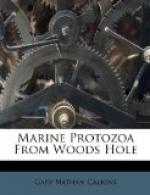Fresh and salt water.
Mastigamoeba simplex, n. sp. Fig. 7.
A very small form, first seen in the flagellated stage, aroused my interest by reason of the fact that its flagellum lost its regular outline and became amoeboid, turning to a pseudopodium, while at the same time other pseudopodia were protruded from different parts of the periphery. In this condition ectoplasm and endoplasm could be made out with the clearest definition. After the pseudopodia were well formed, the body became flat and closely attached to the glass slide. In a short time one of the pseudopodia became longer than the rest; the body became more swollen; the pseudopodia were gradually drawn in, with the exception of the more elongate one; this became active in movement and finer in diameter, until ultimately it formed a single flagellum at the anterior of a small monadiform flagellate. The process was repeated two or three times under my observation, so that I am convinced that it was not a developmental form of some rhizopod. Several of them were seen at different times during the summer, and they were always of the same size and form in the flagellated or amoeboid condition. I did not make out their reproduction, and I shall not be satisfied that this is a good species until their life history is known.
In decaying algae. Length 10 mu.
[Illustration: Fig. 7.—Mastigamoeba simplex.]
Genus CODONOECA James Clark ’66.
(Kent ’81.)
Small forms inclosed in cup or “house” of ovoid or goblet shape, colorless and probably gelatinous (chitin?) in texture, and borne upon a stalk. The monad does not completely fill the test. Contractile vacuole single, posterior.
Codonoeca gracilis, n. sp. Fig. 8.
The cup is urn-shaped with a well-defined neck or collar borne upon a shoulder-like end of the body. It is hyaline, colorless, and carried upon a stalk equal in length to the cup or shorter than this. The animal does not fill the cup, nor is it attached by a filament to the latter. There is a single flagellum. The nucleus is minute and lateral in position; the contractile vacuole is in the posterior end of the body. Total length of cup and stalk 21 mu; of cup alone 12 mu. This minute form looked so much like a choanoflagellate that I supposed it to be one until I discovered an empty case (Fig. 8).
[Illustration: Fig. 8.—Codonoecea gracilis.]
Genus MONAS (Ehr.) Stein ’78
(Kent ’81; Buetschli ’86; Klebs ’97; Senn 1900.)
The body is small, globular or oval and either free-swimming or fastened by one of the two flagella. The body is sometimes a little amoeboid, with short pseudopodial processes. In addition to the main flagellum, there are usually one or two small flagella at the basis of the larger one. The nucleus is usually anterior, and one or two contractile vacuoles are present.




